The Tarocchino Bolognese of Giuseppe Mitelli Published by Giordano Berti
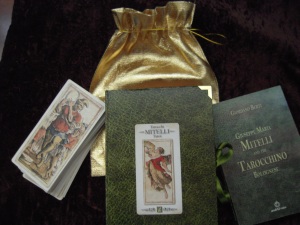
The Tarocchino Bolognese engraved by Giuseppe Mitelli is a unique treasure. Just as the Visconti-Sforza deck was a luxury item commissioned by an aristocrat from a prominent artist in Cremona, this exceptionally beautiful deck was commissioned around 1660 by Count Bentivoglio of Bologna from a prolific Bolognese artist.
Giordano Berti’s version of the deck is a facsimile of a deck published by Trombeta in the 18th century and found in the Bibliothèque Nationale in Paris. Mitelli’s copper plates were retained by the Bentivoglio family, but in subsequent centuries printers made copies of the cards on their own copper plates or wood blocks, attesting to the deck’s popularity.
These cards are 2.5 x 5 inches, with a smooth finish. The backs show the original Trombeta insignia. The cards are wrapped in a metallic gold pouch housed in a sturdy handcrafted box lined with red felt. The green and gold box imitates the color scheme of a deck in the British Museum that was bound into a green leather book.
The accompanying 117-page booklet is stuffed with historical detail and instructions for Bolognese-style cartomancy. I discuss the booklet in detail at the end of this article.
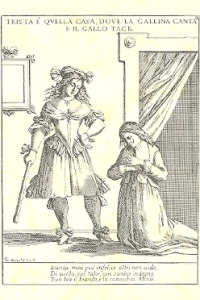 Who was Mitelli? Giuseppe Mitelli (1634-1718) was a charismatic personality who excelled at painting, engraving and sculpture. He was also an outdoorsman, sportsman, actor, and inventor of games and amusements for all levels of society. At least 600 of his engravings exist, including many etchings based on paintings by famous artists of his day. Later in life he focused on etchings with a moral lesson accompanied by explanatory text.
Who was Mitelli? Giuseppe Mitelli (1634-1718) was a charismatic personality who excelled at painting, engraving and sculpture. He was also an outdoorsman, sportsman, actor, and inventor of games and amusements for all levels of society. At least 600 of his engravings exist, including many etchings based on paintings by famous artists of his day. Later in life he focused on etchings with a moral lesson accompanied by explanatory text.
Il Meneghello reproduced Proverbi Figurati (Illustrated Proverbs) a set of 48 etchings by Mitelli. The proverb above the image is explained with rhymed triplets at the bottom. The one shown here is about henpecked husbands. The quote at the top says “Sad is that house where the hen sings while the cock stays silent.”
What’s a Tarocchino? Bologna has a distinct and very old tarot tradition featuring the tarocchino, a shortened 62-card tarot deck with cards two through five removed from the four suits. There is documentation of tarot in Bologna as early as 1441, shortly after Tarot’s invention, and Tarocchino is documented by 1550. The trump cards are the same as a standard tarot with a few variations: the three virtues appear together after the Chariot; the Hermit and Wheel of Fortune switch places; the Angel (Judgment) card is the highest; and the suits of cups and coins have female Pages. The Papesse, Empress, Emperor and Pope are replaced by the Four Moors.
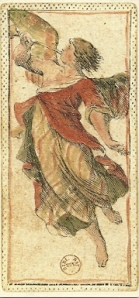
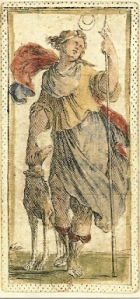 Mitelli’s Tarocchino: Count Bentivoglio received six sheets of paper with ten or eleven copper engravings to a page. Back then, the purchaser was expected to arrange for the engravings to be cut into individual pieces and pasted to a cardboard backing. A few uncut sheets exist in museums today, along with a few sets of cards that have been bound into books. Evidently no cards that were actually used in game playing have survived.
Mitelli’s Tarocchino: Count Bentivoglio received six sheets of paper with ten or eleven copper engravings to a page. Back then, the purchaser was expected to arrange for the engravings to be cut into individual pieces and pasted to a cardboard backing. A few uncut sheets exist in museums today, along with a few sets of cards that have been bound into books. Evidently no cards that were actually used in game playing have survived.
The trump cards of this deck are playful, fanciful and baroque. The imagery emphasizes classical myth—the Sun and Moon are Apollo and Artemis, and the Lovers card is Cupid. In a major departure from the traditional tarot deck, the Papesse and Empress have been replaced by a second Emperor and Pope. This was done at least 60 years before the card makers of Bologna were ordered to replace these trumps with the four Moors, so we can only speculate about Mitelli’s motivation. The figures are rendered in pleasing, soft colors, mostly ecru, coral and teal blue. Bentivoglio heraldic symbols appear throughout, and Mitelli put his self-portrait on the Ace of Coins.
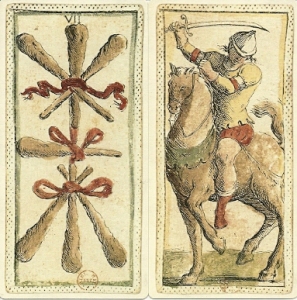 The accompanying booklet by Giordano Berti
The accompanying booklet by Giordano Berti
The 117-page booklet, printed on sturdy paper, is generously illustrated in color and black and white with Mitelli’s engravings and cards from related decks. The book presents Mitelli’s detailed biography, facts about Bologna’s unique tarot traditions, details about how the game was played in Bologna, and illustrations of various editions of this deck through the centuries. Berti debunks in great detail the urban legend that Prince Fibbia invented Tarot in Bologna before his death in 1419. Then we’re told the story of the political uproar in 1725 that led to four trump cards being replaced by four Moors.
The divination chapter, written by a traditional Bolognese card reader, contains exciting new material. Every card is reproduced with a color thumbnail and accompanied by divinatory meanings based on tradition and the author’s extensive experience. We’re also given a list of the trump cards with their traditional meanings as indicators of time. For instance, the Sun card tells you something is going to happen during the day or in one year, while the Death card means something will happen suddenly. We’re given a five-card spread with positions modified to address questions about situations or relationships.
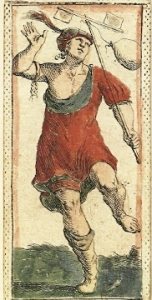 Bologna has the oldest documented tradition of divination with tarot. Playing card researcher Franco Pratesi discovered a sheet of paper from the 1750s giving divinatory meanings for 35 cards, which are reproduced in this book. The list maker didn’t forget the rest of the deck. Card readers in Bologna reduced the 62-card Tarocchino even further to 35, 45, 50 or 55 cards. The number five seem to be very significant in Bolognese cartomancy, so cards were read in sets of five.
Bologna has the oldest documented tradition of divination with tarot. Playing card researcher Franco Pratesi discovered a sheet of paper from the 1750s giving divinatory meanings for 35 cards, which are reproduced in this book. The list maker didn’t forget the rest of the deck. Card readers in Bologna reduced the 62-card Tarocchino even further to 35, 45, 50 or 55 cards. The number five seem to be very significant in Bolognese cartomancy, so cards were read in sets of five.
Only 900 copies of this deck were produced. If you love beautiful cards, and if you are fascinated by tarot history, this deck and book set are indispensable.
Contact Berti for purchasing information through the Rinascimento Italian Style Art facebook page
Read an illustrated article on Bolognese tarot at TarotWheel.net


Hi Sherryl, thanks for this lovely review and thanks for referring to my website. Just one correction, on the Mitelli deck there is no second Emperor, the Popess has been replaced by a second Pope. In the Tarocchino game, the Emperor, Empress, Popess and Pope were called the four Popes and they had all the same value. So it was not a big deal to replace the image of the Popess by a second Pope. For your information, the Berti deck is apparently based on a copy that is conserved in the French National Library. The colors of the deck are not original, while the original cards are only black and white. For this reason you will not find two Mitelli decks with identical colors. I still hate the white borders around all Berti reproductions of historical decks, including this one, but this is a personal opinion. Iolon
Thanks so much for your comments, Iolon. I’m going to disagree with you on one thing. In this deck there are two guys wearing papal crowns, and two others who have regular crowns and are both holding orbs and scepters – obviously secular rulers. Was Mitelli taking artistic license and having two each instead of the four popes that are traditional in the Tarocchino? (Doesn’t look like I can post the photo I took in a comment).
Hy Sherryl, you were right. I was confused by the order in your sentence “the Papesse and Empress have been replaced by a second Emperor and Pope”. So I understood that the Papesse (first called) had been replaced by a second Emperor (also first called) and I ignored the second part of your comparison. So here we agree, there are two Popes. However, I do not see two Emperors, I clearly see one Emperor (seating, short hair and a beard) and an Empress (standing, long hair and no beard, clearly a lady to me). Thanks for your correction, I should better read what you are writing. Iolon